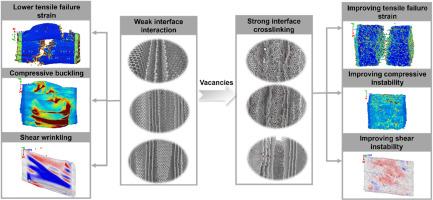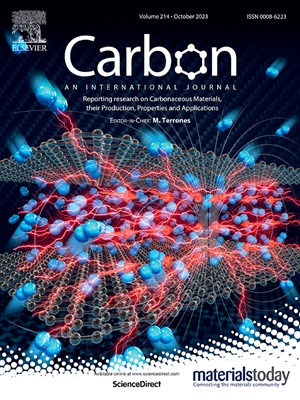Vacancy-induced interfacial crosslinking in graphene/carbon nanotube composites and its influence on mechanical behaviors: A molecular dynamics simulation
IF 10.5
2区 材料科学
Q1 CHEMISTRY, PHYSICAL
引用次数: 0
Abstract
Although defects such as vacancies may degrade the in-plane mechanical properties of graphene and carbon nanotube (CNT), they may also promote interfacial crosslinking and load transfer, and thus enhance the mechanical behavior of graphene- and CNT-based composites. The balance between these effects is crucial for optimizing the design of graphene- and CNT-based composites. Herein, molecular dynamics simulations were constructed to unravel the effect of vacancy-induced interfacial crosslinking on the mechanical behaviors of graphene/CNT composites. Higher defect concentrations led to a higher density of sp3 C–C bonds at the interface, which reduced the tensile failure stress but increased the tensile failure strain. Meanwhile, the layer-by-layer failure transformed into a brittle failure. During compressive loading, the composites tended to buckle in the lower defect concentration range (<0.5 %) but exhibited outstanding buckling resistance at higher defect concentrations (5 %, 10 %). Shear loading led to wrinkling, and deformation instability was suppressed at the higher defect concentration, and all the composites demonstrated a layer-by-layer failure mode. Furthermore, the composites with a higher concentration of defects demonstrated excellent recoverable behavior during compressive loading. The results provide insights into the interface-dominated performance of graphene/CNT composites and help guide their design and fabrication.

石墨烯/碳纳米管复合材料中空位诱导的界面交联及其对力学行为的影响:分子动力学模拟
虽然空位等缺陷可能会降低石墨烯和碳纳米管(CNT)的面内机械性能,但它们也可能促进界面交联和载荷传递,从而增强石墨烯和 CNT 复合材料的机械性能。这些效应之间的平衡对于优化石墨烯和 CNT 复合材料的设计至关重要。在此,我们构建了分子动力学模拟,以揭示空位诱导的界面交联对石墨烯/碳纳米管复合材料力学行为的影响。缺陷浓度越高,界面上的 sp3 C-C 键密度越高,从而降低了拉伸破坏应力,但增加了拉伸破坏应变。同时,逐层破坏转变为脆性破坏。在压缩加载过程中,复合材料在较低的缺陷浓度范围(0.5%)内倾向于屈曲,但在较高的缺陷浓度范围(5%、10%)内表现出出色的抗屈曲性。在较高的缺陷浓度下,剪切加载导致起皱,变形不稳定性受到抑制,所有复合材料都表现出逐层破坏模式。此外,缺陷浓度较高的复合材料在压缩加载过程中表现出优异的可恢复性。这些结果有助于深入了解石墨烯/碳纳米管复合材料以界面为主的性能,并为其设计和制造提供指导。
本文章由计算机程序翻译,如有差异,请以英文原文为准。
求助全文
约1分钟内获得全文
求助全文
来源期刊

Carbon
工程技术-材料科学:综合
CiteScore
20.80
自引率
7.30%
发文量
0
审稿时长
23 days
期刊介绍:
The journal Carbon is an international multidisciplinary forum for communicating scientific advances in the field of carbon materials. It reports new findings related to the formation, structure, properties, behaviors, and technological applications of carbons. Carbons are a broad class of ordered or disordered solid phases composed primarily of elemental carbon, including but not limited to carbon black, carbon fibers and filaments, carbon nanotubes, diamond and diamond-like carbon, fullerenes, glassy carbon, graphite, graphene, graphene-oxide, porous carbons, pyrolytic carbon, and other sp2 and non-sp2 hybridized carbon systems. Carbon is the companion title to the open access journal Carbon Trends. Relevant application areas for carbon materials include biology and medicine, catalysis, electronic, optoelectronic, spintronic, high-frequency, and photonic devices, energy storage and conversion systems, environmental applications and water treatment, smart materials and systems, and structural and thermal applications.
 求助内容:
求助内容: 应助结果提醒方式:
应助结果提醒方式:


